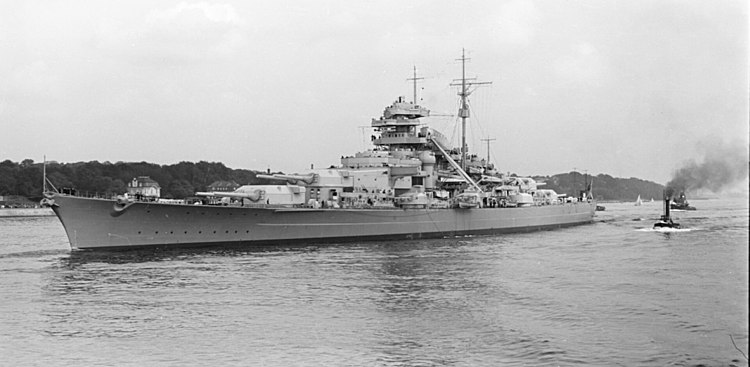KMS Bismarck
KMS[1] Bismarck was a German Schlachtschiff (battleship) that was commissioned by the navy in 1940. One of two Bismarck-class battleships deployed by the navy in World War II its sister-ship was KMS Tirpitz. Bismarck had four turrets of two 15" naval guns each, so she was slightly undergunned in comparison with the 16" and 18.1" guns of contemporary American and Japanese battleships.
Battle of the Denmark Strait
Having been commissioned in 1940, Bismarck undertook Operation Rheinübung in May 1941, accompanied by the light cruiser KMS Prinz Eugen. Admiral Günther Lütjens was in tactical command of the task force; Captain Ernst Lindemann was the commanding officer of Bismarck. The purpose of Rheinübung was to disrupt allied convoys crossing the Atlantic.
Once the British became aware of the sortie, they put heavy ships on each possible approach. In the Battle of the Denmark Strait on 24 May, the German ships encountered the battlecruiser HMS Hood and the new battleship HMS Prince of Wales, which was still in shakedown with shipyard technicians aboard. When Bismarck fired on Hood, one of its first salvos was a direct hit on the main ammunition magazine. There was a massive explosion which split Hood in two and it quickly sank with only three survivors. Prince of Wales, having sustained casualties and damage, laid down a smokescreen to head for port, though it later turned back and took part in the chase. Bismarck itself had sustained hits which caused a serious oil leakage. Prinz Eugen was detached from Bismarck and ordered to continue the mission while Bismarck headed to Brest for repair.
Sinking
Bismarck eluded the Royal Navy pursuers until a coded radio message from Lütjens to the navy was intercepted and decrypted by Bletchley Park codebreaker Jane Fawcett on the 25th. Two Consolidated PBY Catalina flying boats, based on Lough Erne in Northern Ireland, were sent out to patrol the Atlantic approaches to Britanny and Biscay. At 10:30 am on the 26th, one of the Catalinas found Bismarck 690 nautical miles northeast of Brest. The Home Fleet had no chance of catching her but the Force H formation was steaming north from Gibraltar and included the aircraft carrier HMS Ark Royal with a flight of Fairey Swordfish torpedo bombers. The Swordfish located Bismarck and attacked it using torpedoes with contact detonators. A torpedo hit the port rudder assembly, causing the rudder to jam in a 12° turn to port so that the ship was left steering in circles southwest of Ireland. Heavy ships of the Home Fleet engaged her and caused enormous structural damage before the destroyer HMS Dorsetshire launched a torpedo attack which sank Bismarck. It is understood that crew members tried to initiate scuttling so that the ship would not be captured by the British, but there is little doubt that sinking was inevitable once Dorsetshire's torpedoes struck. Of the crew, only 110 survived from a complement of over 2,300. Lütjens and Lindemann were among the fatalities.
Wreck
The wreck is some 400 miles southwest of Ireland and about 600 miles due west of its intended destination at Brest. It was discovered in 1989 by an oceanographic expedition led by Robert Ballard. It was found on the sea bed in an upright position at a depth of over 15,000 feet.[2]
References
- ↑ KMS = navy Schiff
- ↑ Bismarck – German ship. Encyclopaedia Britannica.
